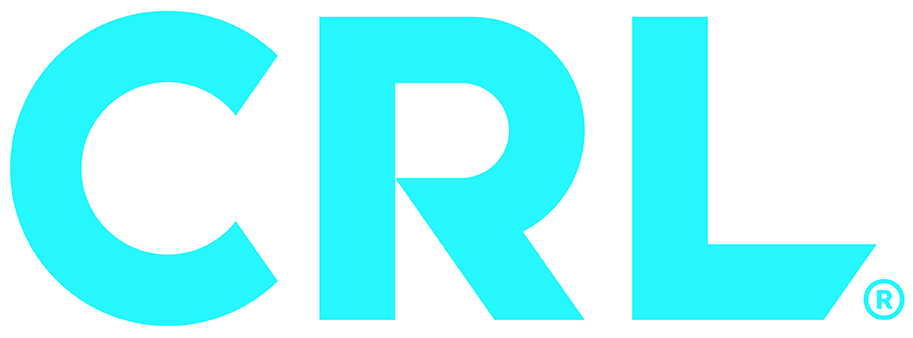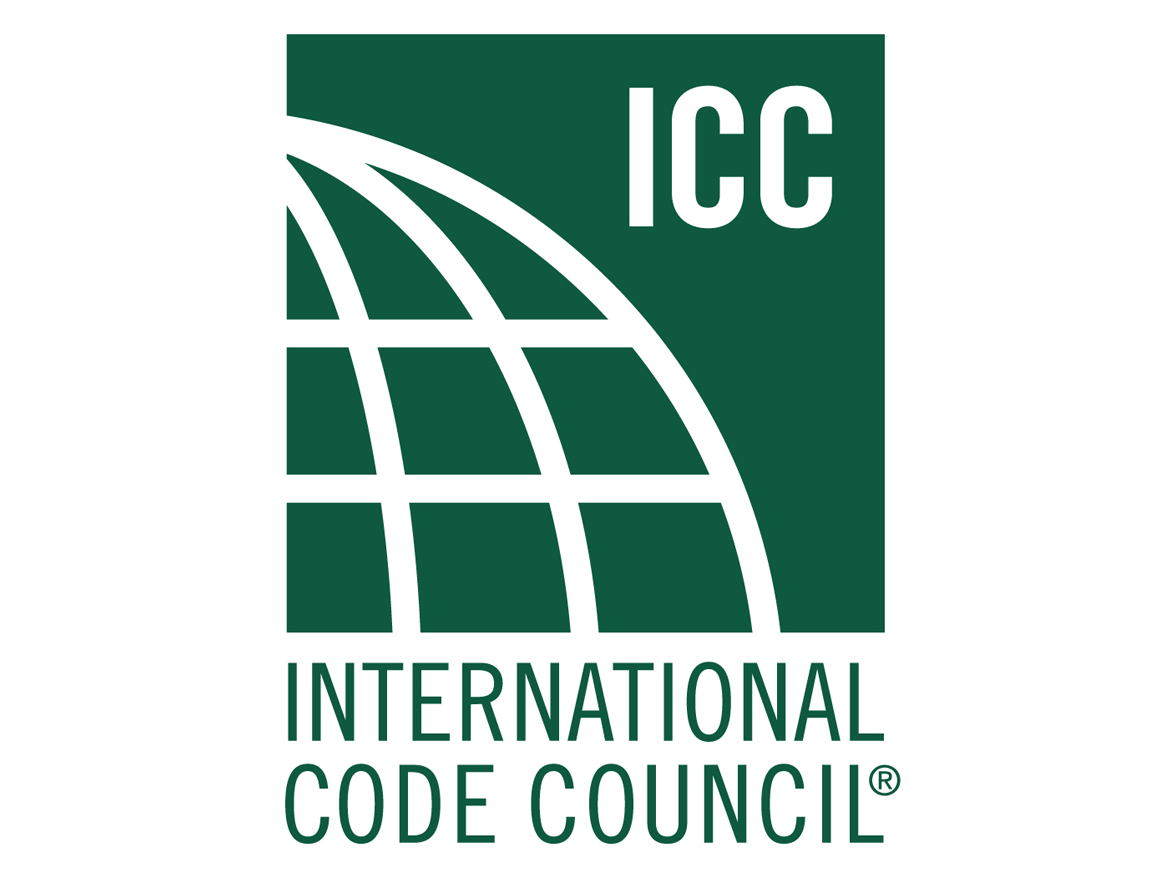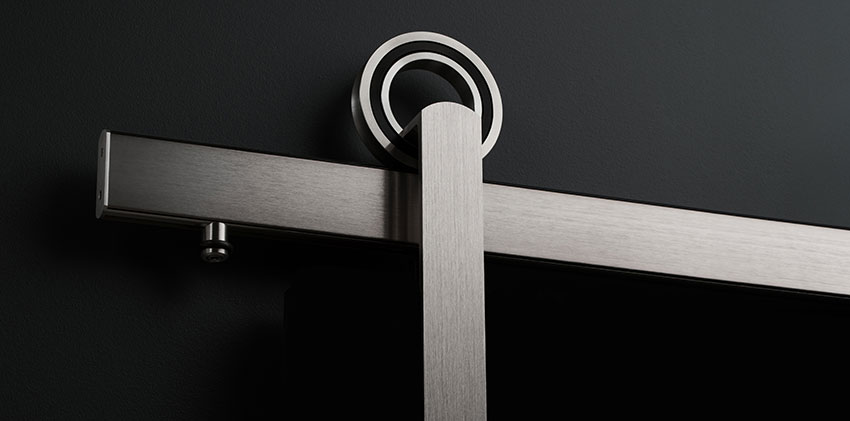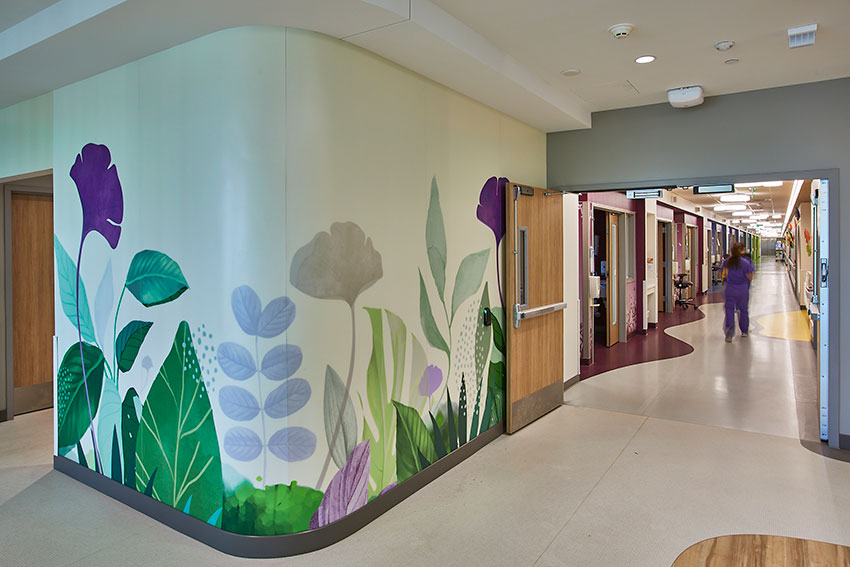
Photo courtesy of CRL; © Benjamin Benschneider
Elements that enrich the visual experience of the occupant are a key trend in commercial design.
In the face of a world that feels increasingly more cluttered and overwhelming, interior design trends are shifting toward a simpler, streamlined form. Carefully curated color palettes, one or two juxtaposed textures, and warm materials blend to create sleek and harmonious interiors. This trend is exemplified by the expansive use of glass and single, large visual installations.
Big artwork is supplanting busy gallery walls. “Utilizing large statement pieces can make a powerful visual impact to your space, and is perfect for immediately creating a unique, bold energy,” said Dana Anderson of Planning Interiors Inc. in Georgia.1
In terms of materials, glass remains at the top in both interior design and building facades. “Glass can absorb, refract, or transmit light. It has the ability to make any building look more stunning and modern,” said Michael Tobias, Founding Principal of NY Engineers. “Using glass in building facades and interiors enhances the ambience. Interiors appear larger and more open, with abundant natural lighting.”2
“The idea of taking small spaces and expanding them through the use of glass and natural light is as old as glass itself,” said Kyle Matthews, AIA NCARB, Principal, JUST Architecture & Design, Ltd.
When used in combination, or separately, innovations in printed wall protection and glazing partitions offer ideal platforms to shape emergent interior design.
ENHANCING THE INTERIOR VISUAL EXPERIENCE HEADING
The new office interior delivers an unbroken and welcoming landscape, defined subtly by glass partitions and carefully honed visuals that promote daylighting and communicate a streamlined, harmonious aesthetic.
Harnessing the Power of Glass
Glass spans are conducive to dynamic workspaces. Contemporary designs that meet the evolving and holistic needs of today’s office employees are leveraging the beauty and versatility of glass partitions. Scalable glass wall solutions seamlessly define interiors and can be easily customized to the specific needs of a project. Glazed partitions can accommodate conference rooms, office fronts, study rooms, waiting rooms, and lobbies. With the thoughtful efforts of architects, designers, and the glazing community, advanced products and fresh approaches are ushering in a new era of office designs that address key environmental and personnel objectives of constantly adapting workplaces. Whether organizations are pursuing a full-time return or hybrid models, the objectives of the new office environment, and the designs that support those objectives, have been fundamentally transformed. Issues impacting employee well-being, including physical, social, and emotional elements, are central considerations. There are also critical environmental goals that must be accounted for: energy-saving strategies, sound management, and privacy. To meet these evolving needs, innovative new lines of interior glass partitions have been developed for next-generation workspaces.

Photo courtesy of Inpro; © Dan Schwalm
Large-scale visuals allow facilities to customize their walls and clearly communicate a unique design experience.

Photo courtesy of CRL; ©Benjamin Benschneider
Transparency, daylight, and the ability of space to evolve are all characteristics enabled by glazed partitions.
Balancing aesthetic objectives with workplace requirements remains essential. The visual impact of office design is still a critical component when creating both engaging and collaborative spaces, especially within an environment where employees have heightened expectations about how an office space should function. In a research poll of 1,614 North American employees, Harvard Business Review found that access to natural light and views of the outdoors are the number one most desired attribute of the workplace environment, outranking stalwarts like onsite cafeterias, fitness centers, and premium perks including on-site childcare.3 Given this demand, the trend toward glass partitions, which facilitate these desires, is increasing dramatically. Framed, frameless, and freestanding-post partition systems can all have distinct visual impacts in office settings that make a space truly unique. These systems offer a high level of customization. Pivoting and sliding doors that complement glazed partition systems are available with a wide array of door handles such as ladder pulls and deadbolt handles.
Design strategies that deliver energy savings are also essential for today’s designs. Glass partitions play an important role in achieving energy usage goals by replacing opaque partition systems with transparent glass walls. Transparent glass walls can decrease reliance on interior lighting during daytime hours, reducing electrical consumption. By minimizing obstructions, glass partitions excel in allowing natural daylight from exterior-facing windows to diffuse through the interior spaces of an office. With documented research dating back to 1986, daylighting also has consistently been associated with improved mood, enhanced morale, less fatigue, and reduced eyestrain.4 Bright lighting enables enhanced focus and alertness, and well-daylit spaces are generally perceived by occupants to be “better" than dim, gloomy ones.5 Interior glass partitions also permit views of the exterior from multiple points. The consequent reduction of reliance on electrical sources for producing interior light lowers energy costs and decreases a building’s carbon footprint. Depending on the lighting control system used, how well the space is daylighted during occupied hours, and the intended functions of the space, multiple studies in office buildings have recorded energy savings ranging between 20% to 60%, when daylighting is used in place of electric lighting.6 Increasing the use of natural resources, such as daylight, by careful use of windows and glass within the built environment, reduces dependency on fossil fuels as well as the combustion of greenhouse gases.
Additionally, the positive psychological impacts of more natural light are a significant benefit to the overall well-being of occupants. Surveys demonstrate that most office workers would like direct sunlight in their offices in at least one season of the year7 and believe that working under natural daylight is better for their health and well-being than electric lighting.8 Using glass partitions allows workers to enjoy distant, diverse, and dynamic views from the interior and establishes a link to the surrounding environment which fosters connection and creativity.9
Transforming Walls into Art
Another key emerging trend is simplifying the visual narrative in a design. A single large visual element, carefully chosen, can define a space and clearly communicate a narrative. For architects seeking to maximize visual impact in their designs, manufacturers are providing new, high-tech solutions applied through common architectural products.
Walls are one of the largest elements of the interior. Adding design, integrated throughout areas with required wall protection, gives walls an additional purpose while expanding their longevity and enhancing protection against damage. Designers can now incorporate high-end, custom, and digital artwork optimized for protective wall products. Durable wall panels are typically used in high-traffic spaces prone to damage and deterioration. Specifying printed wall protection provides not only a protective wallcovering that can be applied directly to the wall at virtually any size but also becomes a perfect host for powerful visual design. When the graphic is back-printed onto clear sheet, like polyethylene terephthalate glycol (PETG), the custom artwork, photography, or image remains vivid and will not get scratched over time. New digital imaging and printing techniques have enabled endless possibilities when it comes to adding art to architectural products, including wall coverings, panels, shades, and signage. Both stock photography and original artwork from artists can be showcased through architectural products. Through this medium, art is no longer something relegated to hang on the wall as an ornament; it can be transformed into something that is ultimately functional and unlimited by size. Complete customization enables architects and designers to create unique, one-of-a-kind products that produce an unforgettable experience for building occupants. The colors, material, textures, and impact-resistance levels of these products also offer designers and facility staff limitless options to enhance the aesthetics of a facility’s interior, while delivering much-needed protection to the edifice itself.
In areas that do not need enhanced protection, printed wall art offers the same range of completely customizable design options, enabling the professional to choose impactful photography, logos, or colors to align with the brand and continue the design scheme. Additional architectural materials, such as printed signage, allow art and color to be further integrated in creative ways throughout the space. These include printed cubicle curtains, window treatments, and shower curtains, made from polyester, vinyl, and acrylic, all of which can be combined with digital print capabilities.

Photo courtesy of Inpro
The new diversity of colors, material, and textures of impact-resistance products offer designers and facility staff limitless options to enhance the aesthetics of a facility’s interior.
Understanding the Power of Visual Experience
Using art within a building creates inspiration, fosters education, promotes wayfinding and can bolster branding. Through the careful selection of products and materials to carry forward their artistic vision, architects, designers, and facility managers can create an artistically integrated space. Because of innovations in digital printing capabilities, artistic possibilities for a design are limited only by the designer's imagination. Art, printed on an architectural product, can bring a brand, an idea, or even a feeling to life.
Using art in design has benefits beyond aesthetics. Beauty in architecture nourishes the human emotional brain argues Semir Zeki, Professor of Neuroaesthetics at University College London. Engaging with art is essential to the human experience, write Brian Kisida and Daniel H. Bowen. “Almost as soon as motor skills are developed, children communicate through artistic expression. The arts challenge us with different points of view, compel us to empathize with ‘others,’ and give us the opportunity to reflect on the human condition. Empirical evidence supports these claims: Among adults, arts participation is related to behaviors that contribute to the health of civil society, such as increased civic engagement, greater social tolerance, and reductions in other-regarding behavior.”10
Imagery is also a highly effective strategy for increasing comprehension, reports The University of Kansas Department of Special Education. Imagery strategies involve activating the memory by taking what is to be learned and creating meaningful visual, auditory, or kinesthetic images of the information.11 Findings from Houston’s Arts Access Initiative provide strong evidence that arts educational experiences can produce significant positive impacts on academic and social development in children. School students exposed to art experienced a 3.6 percentage point reduction in disciplinary infractions, an improvement of 13 percent of a standard deviation in standardized writing scores, and an increase of 8 percent of a standard deviation in their compassion for others.12

Photo courtesy of CRL
Sophisticated glazed designs make a visual statement using remarkable simplicity.

Photo courtesy of CRL
Movable walls open a floor plan to create multi-functional and dynamic interior spaces. They also promote daylight diffusion within interiors, which can help with employee morale and reduce dependency on artificial lighting.
Adding imagery within a design brings continuity throughout the building and guides how people interact with the space. Wayfinding is particularly important in complex built environments, such as urban centers, healthcare settings, educational campuses, and transportation facilities.13 As architectural environments become more complicated, people need visual cues such as maps, directions, and symbols to help guide them to their destinations. In these often high-stress environments, effective wayfinding systems contribute to a sense of well-being, safety, and security.14
The innovative fusion allowed by advances in printing technology, therefore, incorporates high-impact durability with customizable, inspired designs that can transform any space both visually and functionally.
SPECIFYING GLASS TO ACHIEVE CLEAR DESIGN GOALS
"When designing interiors, particularly commercial, it's important to understand the needs of not only the owner but the end occupants," said Mark Suehiro, product technical director at CRL. "When the occasion arises, specifying the right interior glass partition systems can go a long way in promoting employee collaboration and occupant morale, all while meeting an open, contemporary design intent."
Continuous and innovative advancement in glazed partitions can deliver exceptional, customized office partition walls for any design, including scalable fixed and moveable glass wall systems. Hardware innovations include an advanced soft-brake mechanism for sliding doors, which has reduced the two-bodied double soft-brake system found in typical sliding glass doors to one component. This re-engineered soft brake is also scaled down to a compact 16-15/16-inch length for more robust performance and increased durability.
Interior glass partition walls are a stylish and practical way to elevate interiors. Glass partition walls allow light to flow throughout the space and promote transparency, and at the same time, maintain the quiet areas an office needs to be most productive. The glass selection can also maximize daylight diffusion while eliminating glare. Whether ensuring abundant natural light for all employees or creating an open conference room to encourage the exchange of ideas, glass office partitions create a customizable, bright, and productive space.
A freestanding glass wall solution seamlessly defines interiors and can be adapted to the specific needs of a project. Numerous configurations allow architects and glaziers to use any combination of end posts, center posts, and corner posts. Other modern glazed partitions utilize concealed glass channels and no vertical extrusions to produce expansive, visually unbroken glass spans that are conducive to dynamic workspaces. These glass partition walls can pair with other interior systems and commercial glass door hardware. Optional pivoting and sliding doors are available with a wide array of door handles such as ladder pulls and deadbolt handles. Generally, these systems offer a high level of customization.
Operable glazed doors are sometimes designed with a low-profile door frame and vertical extrusions, setting them apart from traditional framed partition systems. This leads to greater visibility and daylight diffusion and less visual disruption. These doors use height-adjustable hinges that do not require drilling. Door-to-wall and door-to-glass frame sets are available, along with unique floating door transoms that can produce floor-to-ceiling glass spans.
Glass type is typically laminated or monolithic. Standard sizes include 5/16", 3/8", and 1/2" monolithic tempered glass, or 9/16” laminated glass. Glass panels using 1” insulating glass provide sound attenuation for enhanced privacy in applications such as government buildings, law firms, executive offices, human resource departments, and conference rooms.
With the demand for adaptable spaces that quickly accommodate change, the industry is seeing a trend toward large-scale movable walls being specified, including sliding glass doors and bi-folding glass doors. These doors become, in effect, movable walls that can open up a floor plan to create multi-functional and dynamic interior spaces. Movable glazed walls carry the same benefits as glazed partitions: they promote daylight diffusion within interiors which bolsters employee morale and reduces dependency on artificial lighting. Movable walls can be specified to incorporate double-glazed insulating glass, which helps mitigate sound to improve privacy. Finally, movable walls have a large scale which helps form contemporary visuals.
Movable wall sliding door systems, with a maximum panel width of 7 feet and height of 13 feet, deliver expansive scale and elegance. Advanced engineering provides for smooth, quiet operation, requiring minimal force to move expansive glass panes. Systems that utilize bottom rolling tracks eliminate strain on the overhead beam. Panel loads are evenly distributed across the bottom rolling components resulting in a fluid, frictionless glide. The precision-engineered stainless-steel track further facilitates panel movement. Most notably, a CW40 Performance Grade rating denotes systems well-suited even to exterior applications where high loads, limits on deflection, and heavy use are likely.
Bi-folding doors represent a staple in movable wall systems, offering the most desirable features in looks and performance. Some offer a distinctly slim 4-3/4” vertical sightline and 1-7/16” panel rails to reduce visible hardware and produce a minimalist aesthetic that maximizes views. When closed, door hinges can be completely concealed to deliver an elegant and streamlined look. Superior thermal and structural performance is provided by using a 3-1/2” system depth. Depending on the manufacturer, these systems can also earn a distinguishing CW40 Performance Grade rating that makes the doors ideal for exterior applications where larger sizes, higher loading requirements, limits on deflection, and heavy use are expected.
Advances from glazing manufacturers offer design professionals exceptional performance in movable glazed walls without compromising aesthetics and function. These assets can be transformed into vibrant, adaptable interiors.
MAKING DESIGN DURABLE
Innovations in printing technology allow powerful visuals to transform from an art piece into a durable installation that also significantly enhances the longevity and maintenance of interior spaces.
“A misconception among architects and interior designers about printed wall protection might be that its primary function is purely aesthetic, underestimating its durability and protective qualities,” said Sarah Martell, Interior Designer at Inpro. “They might view this product as simply a decorative element rather than a robust solution that also significantly enhances the longevity and maintenance of interior spaces.”
Premier printed wall protection products offer an ideal fusion of high-impact durability with completely customizable artistic designs that can transform any space, both visually and functionally. This solution allows art and graphics to be built directly into the construction scope, helping designers create commercial settings that achieve business goals and support occupants.

Photo courtesy of Inpro
The possibilities are exponential when using imagery on printed wall protection–the wall can not only take an impact, but also make an impact.
Beautifully Resilient Images
Printed wall protection provides walls with additional purpose.
The scientific principle that matter moves from order to disorder applies, unfortunately, to buildings. What once was sparkling and new can slide into disrepair and become unsightly. Architects and design professionals can slow the hands of time–and increase the longevity and sustainability of an interior–by thinking long-term and specifying products that not only preserve their design but also serve building owners in preserving a structure long after the ribbon is cut. This can mean, in high-use areas, selecting products that protect the planned interior from accruing damage in the first place. Products that are durable necessarily enhance the longevity, and sustainability, of the entire environment. With sustainability’s rise to the forefront in architecture and construction, products and systems continue to innovate to provide the architect, the design professional, and the client opportunities to meet the needs of the present without compromising the ability of future generations to meet their own needs. The ability to be sustainable continues to expand.
Door and wall protection products serve as preventative “medicine” to keep facilities looking good, long after the ribbon cutting. A list of these products can be found in CSI MasterFormat Division 10 26 00–Wall and Door Protection:
- Corner Guards
- Bumper Guards/Wall Guards
- Bumper Rails
- Protective Corridor Handrails
- Protective Wall Covering – rigid polymer sheet, solid surface wall cladding, flexible protective wall covering
- Door and Frame Protection – kickplates, door frame guards
When beginning a new construction or renovation project, predictive planning provides the design team with an edge. To prevent damage, the team specifically identifies areas of concern, potential causes, and levels of abuse, and then matches the targeted wall protection based on its size, impact absorption, need for weight bearing, as well as the aesthetic desired. The colors, material, textures, and impact-resistance levels of these products offer designers and facility staff limitless options to enhance the aesthetics of a facility’s interior, while also delivering much-needed protection.
Targeted Wall Protection is a set of specific products designed to absorb impact and protect the underlying wall. These products cover only part of the wall but function to provide a higher level of impact resistance. Protective wall coverings are engineered with rigid sheet wall protection to endure the toughest commercial damage. The targeted wall protection needed is based on its size, impact absorption, weight-bearing, and desired aesthetic. Examples include corner guards and wall guards. Wall Guards perform as their name implies: these products guard the wall. Sometimes wall guards are referred to as Crash Rails. The two most common forms are multi-component systems and single-material systems. Wall guards are designed to take impact dead on, into the face of the guard. Cover materials include all extruded plastics. They offer long service life with durable covers and end caps, which can be replaced.
Considerations When Specifying Rigid Sheet Wall Protection
Placement, material type, and finishes are critical elements of wall protection selection.
- Selecting the right material. What level of impact resistance is needed? What type of material makes up the wall? Does the material need to be non-porous, or have the ability to endure frequent, stringent cleaning protocols without fading, warping, or staining?
- Sheets versus rolls. Sheets allow for higher levels of impact resistance. Rolls can accommodate half-wall or wainscot applications and provide a significant reduction in seams, which gives a smoother, less interrupted finish.
- Finishing touches. When deciding between a trim versus caulk finish, trim provides a more highly finished look to the installation but is more expensive to furnish and install. Caulks finish the seam only.
- Adding imagery, woodgrain, colors, or patterns to the protective elements.
- Ensuring proper installation. Smooth and proper adhesive installation is critical. As with all wall coverings, proper surface preparation and adhesive are critical to prevent mold behind wall cladding.
By specifying the right materials, and choosing to add imagery, occupants and staff can enjoy both a striking design and significant savings by stopping damage before it happens. The colors, material, textures, and impact-resistance levels of printed wall protection offer designers and facility staff limitless options to enhance the aesthetics of a facility’s interior. Thanks to innovations in digital printing technology, designers no longer have to compromise their visions by using drab institutional products in high-traffic areas, nor do they have to sacrifice durability for aesthetics. Using PETG protection guarantees the longevity of the image even under hard wear and clear sheet back-printing maintains graphic vibrancy without scratches.
“Code-driven requirements to provide cleanable wall surfaces in many occupancies often force architects to use FRP panels, which, despite being easy to clean, are fairly unattractive and boring,” says Kyle Matthews, AIA NCARB, Principal, JUST Architecture & Design, Ltd. “The ability to take a wall which would otherwise be functional and make it aesthetic offers new opportunities.”
The investment in high-quality wall protection products also makes it much easier to maintain a clean, well-kept facility appearance that makes a positive impression on both clients and employees. Manufacturers using PETG and other durable surfaces allow antibacterial all-purpose cleaners to be used and some products accept the use of bleach, degreaser, and other cleaners to guarantee sterile surfaces.
Art for the Occupants’ Sake
Americans, on average, spend approximately 90 percent of their time indoors.15 That means the average person employs a minimal 10 percent, or less, of their time engaged with natural spaces. Yet, individuals say that interconnection with the natural environment is one of their most desired aspirations. For this reason, interior design is playing a larger-than-ever role in what people see and experience.
Adding imagery throughout the built environment brings continuity to both the building and the occupant experience. With the right materials, design professionals can craft a striking design and ensure sustainability and significant savings by stopping damage before it happens. Furthermore, artworks can provide a cohesive narrative and health benefits to occupants when they are placed in harmonious relation to one another.
Evidence-Based Design indicates the importance of using interior spaces to foster the missing link to nature. Natural forms remain an important visual asset. Humans have an innate affinity for the life-supporting aspects of the natural world. This attraction to nature is referred to as biophilia, a term literally meaning "love of nature". Data from studies within healthcare spaces demonstrates that biophilia helps occupant mood, assists in healthcare settings for both patient and staff and can decrease time spent in recovery for patients. “Incorporating art and artisanal pieces into healthcare environments humanizes the experience, creates a sense of calm, and presents an opportunity to welcome others into these spaces,” said Cheryl S. Durst, executive vice president and CEO of IIDA.16 Evidence increasingly shows that biophilic design boosts mental health, healing, and creativity in any occupied space.
Understanding this inherent attraction to the natural world has spurred innovation in the architectural community. Designers are capturing opportunities to reconnect occupants with nature by incorporating biophilic elements in their designs, particularly where views to the outside are unavailable or confined. Working through digital imagery or prints on an architectural product, art that features biophilia can play an impactful role.
Although wall protection panels may seem like just another new expense, they can eliminate hidden maintenance costs while offering the additional opportunity of hosting art to improve the overall experience of occupants. Additionally, manufacturers offer printed wall protection that is environmentally friendly, may contribute to LEED credits, can satisfy Class A Fire Rating, and can earn UL GREENGUARD certification.
DESIGN THAT SUPPORTS THE UNSEEN ADVANTAGES
How they look and how they function are vital parameters to interior design. How materials protect the health and safety of the people who use them every day is also critical. Factors like sound privacy, sound control, and sustainability may not be visible, but products that integrate these attributes ensure that the buildings succeed.

Photo courtesy of CRL
When correctly specified, glazed partitions allow for the best of both worlds: transparency and sound attenuation and privacy.
Clearly Erasing the Impacts of Sound
Architects may be under the impression that specifying a single-glazed interior partition system is an adequate step for creating sound privacy, but that is not the case. Normal speech can still be heard. It is important to specify double-glazed systems with Sound Transmission Class (STC) ratings of at least 35 to get the sound privacy desired.
To help design professionals engineer better acoustical environments, ASTM E90, ASTM E413, and ASTM E2964 assign products an STC rating, which is an average of their acoustic performance across 18 different sound frequencies. The higher the rating, the more sound is blocked from going through the material. By understanding this rating of materials, the professional can gauge how much sound will be blocked as it passes through those materials. This is especially important in commercial construction. The sound transmission class was first introduced in 1961 and has since become the standard single-number metric to describe sound-blocking materials. In a product with an STC rating of 50 or above, even very loud noises such as operating machinery, musical instruments, and high-volume stereos are reduced to tolerable background sounds.
Industry performance standards and certifications do not normally apply to interior glazed office partitions. However, STC ratings do apply when specifying an acoustic system.
Innovations in glass partitions offer the perfect solution for creating modern privacy areas. With partitions, architects and designers can create office designs providing private work and meeting spaces for individuals or groups while maintaining a vibrant, open-office aesthetic.
An important component of privacy is the reduction of sound transmission throughout the office space. The industry’s Sound Transmission Class (STC) rating system is essential for comparing and contrasting the sound transmission qualities of various interior partition systems. There is a common misunderstanding that a very high STC rating of 40+ for a partition system is needed for effective sound privacy. In practice, for most applications, an STC rating of 37-40 is adequate to achieve the desired sound mitigation for speech.
“Economics and trends toward flexible and shared workspaces are driving personal office space smaller and smaller. Occupant comfort is maximized when we provide light open spaces; these also must provide the acoustic privacy needed to be productive,” said Matthews.
When it comes to improved sound mitigation, framed glass partition systems with dual glass lites are the most effective. Other partitions that feature 1” insulating glass perform to achieve privacy, and act as a buffer for incoming and outgoing speech. To make certain that acoustic requirements are met, glazing partitions and assemblies that need an STC rating of 35 or above should be noted on plans and classified as a special assembly. Glass partition walls allow light to flow throughout the space and promote transparency while at the same time maintaining the quiet environment an office needs to be most productive.
New Enhancements to Sustainability: Circular Materials
Choosing new trends, such as protective wall coverings and glass partitions to enhance the interior ambiance of a project, does not mean sacrificing sustainability and a lower carbon footprint. While designers may elect to install door and wall products to cut down on visible damage and to keep interior surfaces looking new, this product selection translates into extending and preserving the life of selected materials and the structure as a whole, mitigating the need to replace either. Yet beyond the performance of door and wall protection products, sustainability from the very materials chosen can also be captured. Responsible product manufacturers are constantly looking for ways to reduce environmental impact, whether through the manufacturing and recycling of products or through business practices. Manufacturer and product transparency has increased dramatically through documentation such as Health Product Declarations (HPD), Environmental Product Declarations (EPD), and Greenguard Gold Certificates. Gathering the information for these documents also sheds light on the environmental aspects of products at various stages.
Instead of simply sending scrap to landfills, manufacturers are increasingly able to reuse it in a way that creates usable products with greater performance. Manufacturers enrolled in the Zero Waste by 2025 program are repurposing internal scrap to contribute to that goal. Leading manufacturers are operating at almost an 80 percent overall diversion rate based on production efficiencies, and internal recycling of PVC, metals, and comingled materials.
Takeback programs are also evolving to engage the customer in product recycling. Manufacturer takeback programs allow customers to recycle scrap or removed product, preventing the materials from going to the landfill. These companies are not only committed to going above and beyond, but also are committed to bringing about change in their industry, region, or within their supply chain.
Depending on the material, the recycled product is then able to be reground and turned into new product elements. In addition to the environmental aspects of this program, some material producers incentivize customers who participate with a monetary credit back to their accounts. This system helps to build valuable relationships with customers based on mutual benefits.
Improving interior ambiance and function by embracing new trends and product innovations can benefit both the environment and the well-being of those who use the facility.
END NOTES
1 Anderson, Dana. “2024 Commercial Interior Design Trends to Watch.” Planning Interiors Inc. https://planning-interiors.com/2024-commercial-interior-design-trends-to-watch/. Retrieved April 8, 2024.
2 Tobias, Michael. “Why Is Glass so Common in Commercial Buildings?” Nearby Engineers. https://www.ny-engineers.com/blog/why-is-glass-so-common-in-commercial-buildings. Retrieved April 8, 2024.
3 Meister, Jeanne C. “The #1 Office Perk? Natural Light.” Harvard Business Review. September 3, 2018. https://hbr.org/2018/09/the-1-office-perk-natural-light. Retrieved April 8, 2024.
4 Robbins, C. L. (1986) Daylighting Design and Analysis, New York: Van Nostrand Reinhold Company.
5 Mardaljevic, J. (2012) Daylight, Indoor Illumination and Human Behavior in Encyclopedia of Sustainability Science and Technology Springer-Verlag New York Inc, New York. ISBN 978-0-387-89469-0, pp 2804-2846.
6 Galasiu, A. D.; Newsham, G. R.; Suvagau, C.; Sander, D. M. (2007). "Energy saving lighting control systems for open-plan offices: a field study" (PDF). Leukos, 4(1). pp. 7–29. Archived from the original (PDF) on 13 June 2010.
7 Christoffersen, J., Petersen, E., Johnsen, K., Valbjørn, O. and Hygge, S. (1999) Vinduer og dagslys – en feltundersøgelse i kontorbygninger (SBi - rapport 318) Hørsholm: Statens Byggeforskningsinstitut.
8 Lighting Research Center (2014) Rensselaer Polytechnic Institute, Daylighting Resources – Productivity, http://www.lrc.rpi.edu/programs/daylighting/dr_productivity.asp.
9 Wirz-Justice, A., Fournier, C. (2010) Light , Health and Wellbeing : Implications from chronobiology for architectural design, World Health Design, vol. 3.
10 Kisida, Brian and Daniel H. Bowen. “New evidence of the benefits of arts education.” February 12, 2019. Brown Center Chalkboard, The Brookings Institution. https://www.brookings.edu/blog/brown-center-chalkboard/2019/02/12/new-evidence-of-the-benefits-of-arts-education/. Retrieved May 16, 2023.
11 “Imagery Strategies.” Teacher Tools, Department of Special Education, University of Kansas. https://specialconnections.ku.edu/instruction/cognitive_strategies/teacher_tools/imagery_strategies. Retrieved May 16, 2023.
12 “Investigating Causal Effects of Arts Education Experiences: Experimental Evidence from Houston’s Arts Access Initiative.” Houston Education Research Consortium. Kinder Institute. February 12, 2019. https://kinder.rice.edu/research/investigating-causal-effects-arts-education-experiences-experimental-evidence-houstons-arts. Retrieved May 16, 2023.
13 Lu, Yanhua, BLA. “Creating a Successful Wayfinding System: Lessons learned from Springfield, Massachusetts.” University of Massachusetts, Amherst. February 1, 2017. https://scholarworks.umass.edu/cgi/viewcontent.cgi?article=1089&context=larp_ms_projects. Retrieved April 14, 2024.
14 Hara, Bryan. “Wayfinding: Current & Future Planning.” September 21, 2023. AIA HoustonxDesign 2023. Retrieved https://aiahouston.org/v/event-detail/2023-HXD-Wayfinding-Current-and-Future-Planning/27v/.
15 U.S. Environmental Protection Agency. 1989. Report to Congress on indoor air quality: Volume 2. EPA/400/1-89/001C. Washington, DC.
16 Patterson ES, Sanders EB-N, Sommerich CM, Lavender SA, Li J, Evans KD. Meeting Patient Expectations During Hospitalization: A Grounded Theoretical Analysis of Patient-Centered Room Elements. HERD: Health Environments Research & Design Journal. 2017;10(5):95-110. doi:10.1177/1937586717696700.
Amanda Voss, MPP, is an author, editor, and policy analyst. Writing for multiple publications, she has also served as the managing editor for Energy Design Update.
















